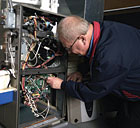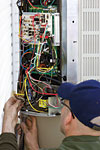
Energy costs, financing costs, and utility rebates may spur customers to replace systems, rather than repair in 2011. (Courtesy of The Unitary Products Division of Johnson Controls Inc.)
According to the Chinese zodiac, 2010 was the Year of the Tiger, although in the HVAC industry, it may be better known as the Year of the Tax Credit. The 25C tax credits were a popular sales tool in the HVAC industry, used to entice homeowners into purchasing high-efficiency HVAC systems in exchange for a $1,500 tax credit. However, these residential tax credits were reduced to $500 at the end of 2010, leading many in the industry to wonder if a drop-off in new equipment sales would be inevitable in 2011.
It seems obvious that the tax credits helped boost sales to some degree in 2010, especially where furnaces and heat pumps are concerned. According to Air-Conditioning, Heating, and Refrigeration Institute (AHRI), year-to-date U.S. shipments of gas warm-air furnaces increased 13 percent in 2010, while heat pump shipments increased 7 percent. Central air conditioner shipments, on the other hand, decreased 3 percent.
Manufacturers are optimistic that sales of new equipment will remain strong this year, although they may not be the high-efficiency units that qualified for the tax credits. “We are anticipating shifts towards minimum efficiencies rather than repair-only scenarios,” said Philip Windham, vice president, sales, Nordyne. “While the industry has seen a high level of repair over the last three years, eventually the systems cannot be repaired any further, and the choice will be to replace or go without. Luckily for all of us, Americans like their air conditioning.”
WHAT HAPPENS NEXT
Even though tax credits led some consumers to replace their old units with high-efficiency systems, the recession forced many others to choose repairing components rather than replacing units. This should change in 2011, said John Hurst, vice president, product marketing, LII residential, Lennox. “An improving economy will shift the mix from component repair back towards system replacement. Many consumers delayed replacement over the last few years due to a lack of discretionary income or an inability to get consumer credit to fund a replacement. As financial institutions increase consumer lending and the economy improves, we expect to see some of the pent-up demand for new systems released in the form of improved industry volume.”Andy Armstrong, director of marketing, unitary products, Johnson Controls (JCI), also believes that replacing will trump repairing in 2011. “Looking at the annual sales of compressor bearing units nationally, it appears there are many units that have been repaired over the past three years. Over time, the repair option becomes less and less attractive. Energy costs, financing costs, and utility rebates, among other factors, will also drive the replacement decision, so we’re not convinced that the repair option is clear cut.”
While there may be pent-up demand for new HVAC systems, rising costs of fuel and base materials are resulting in higher equipment prices, which could dampen the replacement market. Armstrong noted that no manufacturers in the HVAC industry have the ability to absorb significant fuel and raw material costs more than distributors, contractors, or any business people, and eventually the cost must be passed through the channel.

Pent-up demand for new systems – such as the X21 units being installed by Karlos Batista and Chris DeCaprio of Design Air in Hillburn, N.Y. – may improve industry volume in 2011. (Courtesy of Lennox.)
While rising costs usually translate into higher prices, fluctuations in the price of commodities are not new to the HVAC industry, and manufacturers such as Lennox are responding by sourcing initiatives and aggressively reducing costs. “Our challenge is to manage cost without sacrificing quality, reliability, or product innovation,” said Hurst. “We are a disciplined industry. We aggressively manage cost and pass along price increases through the value chain when necessary, although we may see additional price increases to offset future commodity cost headwinds.”
Nordyne is trying to mitigate rising material costs with new innovations, such as its all-aluminum microchannel coils in 13 SEER air conditioners. “That helps some,” said Matt Lattanzi, director of product management, Nordyne, “but at the end of the day, rising costs affect the entire HVAC industry - from our suppliers to distributors to contractors to homeowners.”

Some customers will still opt for high-efficiency equipment, such as the 22 SEER iQ Drive heat pump, but lower tax credits may lead to a shift in the marketplace. (Courtesy of Nordyne.)
THE REFRIGERANT QUESTION
When the manufacture of factory-charged R-22 units was phased out, many in the industry thought that the equipment was gone for good. Customers, however, had a different idea, and in response to their demands, companies started the production of non-charged, or dry R-22 equipment. Goodman offers this option as does JCI, whose Armstrong noted, “Given current policies, it’s clear there is a demand for R-22 units in replacement applications, and we want to be sure our customers have the products they need to compete in the marketplace.”Nordyne also started manufacturing dry units, in response to the dramatic rise in compressor shipments and window air conditioners, which indicated consumers were choosing to avoid a complete system replacement. “Dry R-22 units are a viable option to repairing an older, less-efficient unit in this economy,” said Windham. “It allows dealers an opportunity to sell condensing units along with the supplies that complement a unit changeout. Plus, the homeowner has something new and arguably more efficient for a similar price and can see something tangible after spending their hard-earned money. As long as the price of R-22 remains reasonable, we believe these units will continue to fill a need in the marketplace.”
Some of the Lennox brands also offer dry R-22 condensing units, although Hurst noted that Lennox supports the HVAC industry’s commitment to reduce HCFCs by 90 percent from the 1999 baseline by 2015 and 99.5 percent by 2020. “We will most likely see a broader demand for these products as long as dry units are a cost-effective solution for the end consumer or until the regulatory loophole is closed.”
While production of R-22 is being phased out, many questions remain regarding the future of R-410A. As Lattanzi noted, R-22 served the industry well for over 70 years, but it is unlikely that R-410A will be a 70-plus-year refrigerant. “While R-410A is a fine refrigerant and is significantly more environmentally friendly relative to R-22 on an ozone depletion potential (ODP) basis, the refrigerant is not without its shortcomings. For example, R-410A has a global warming potential (GWP) of 1890, which is viewed as unacceptable by many. R-410A will be the refrigerant for the foreseeable future, but it’s not the end-game refrigerant.”
Lennox also anticipates future regulatory challenges that include the use of new refrigerants, and the company plans to work closely with refrigerant manufacturers to ensure its products are optimized for refrigerants of the future. “There are alternate refrigerants on the horizon that present various technical challenges, but we will continue to innovate to address challenges presented by these refrigerants,” said Hurst.

Proposed new efficiency standards for air conditioners, furnaces, and heat pumps may challenge the industry’s ability to supply quality products that homeowners can afford. (Courtesy of The Unitary Products Division of Johnson Controls Inc.)
EVOLVING ISSUES
The HVAC industry is constantly changing and evolving, and one of the issues that may challenge manufacturers in the near future is regional efficiencies for equipment. In late 2009, Air-Conditioning, Heating, and Refrigeration Institute (AHRI), along with several energy efficiency advocacy organizations, proposed a new efficiency standard for air conditioners, furnaces, and heat pumps. The new standard would create three regions that have different sets of efficiency standards, depending on the climate.Armstrong noted that efficiency changes are challenging for all levels of the industry. “All manufacturers have been forced to make difficult choices to provide quality products at regulated efficiencies. These choices affect prices, size, sound levels, and reliability, as well as capacity. Although higher efficiency supports the end consumer, there are sacrifices for that efficiency. For example, since our shift to 13 SEER, many consumers have chosen to repair much less efficient products, when a 10 SEER solution would have been chosen. Looking forward, the new standards will again challenge the industry’s ability to supply quality products that homeowners can afford and that still meet other expectations - not an easy task.”
Another challenge that faces manufacturers is the continual need to improve products to meet consumer expectations. “Consumers want to be able to manage their lives - including their home comfort needs - on their terms. They are growing increasingly sophisticated about the technology that enables them to exercise more control over their heating and cooling systems. We must develop and build the products that address these factors, in addition to their unmet needs,” said Kevin Carlile, vice president of sales for residential solutions, Trane.
These factors need to feed manufacturers’ product innovation pipeline to ensure that decisions are based on what consumers want rather than on what engineers can dream up, added Carlile. “Instead of building it and hoping consumers come, our products and services are based on a unique understanding of how consumers want to live their lives.”
Hurst agreed that consumers expect to extract more value from their home comfort system, and to deliver the expected value, systems continue to increase in sophistication. “As products become more sophisticated, controls will need to improve the contractor and consumer experience. Lennox leverages technology and innovation to develop systems that deliver comfort and peace of mind to the consumer, while our contractors want products that are easy to sell, install, and service.”
Sophisticated HVAC systems have been accompanied by other advanced technologies that both the consumer and contractor are utilizing to their advantage. Carol Baker, vice president, marketing, Nordyne, noted, “Smartphones, tablet PCs, online video training, social media, and increased computer use are all trends that impact our industry. Based on our own research, we feel that a large portion of HVAC contracting businesses are not quite prepared for the major shifts that are impacting consumer buying behavior. Contractors have to be willing to recognize the opportunity and adapt to a changing world where consumers spend more time online researching their purchases before they make their decisions.”
Ultimately, all this technology benefits consumers in the form of products and services that fit their lifestyles, are easy to purchase, and provide a tremendous amount of comfort and value. “It’s not about the box we sell - it’s about delivering a better quality of life. Our focus is on creating customers for life and building our business, our team, our messages, and our products to deliver solutions that contribute to a better quality of life,” said Carlile.
Publication date:03/14/2011


Report Abusive Comment